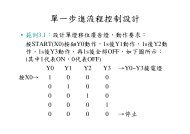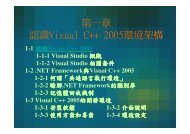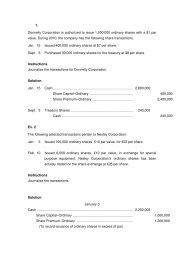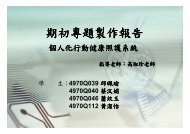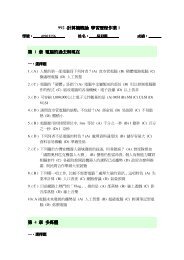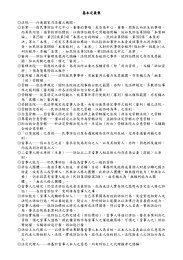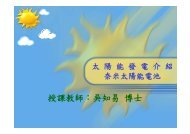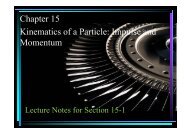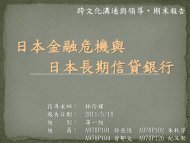Bioresource Technology
Bioresource Technology
Bioresource Technology
You also want an ePaper? Increase the reach of your titles
YUMPU automatically turns print PDFs into web optimized ePapers that Google loves.
Adsorptive removal of copper and nickel ions from water using chitosan coated<br />
PVC beads<br />
Srinivasa R. Popuri a,1 , Y. Vijaya a , Veera M. Boddu b , Krishnaiah Abburi a, *<br />
a Biopolymers and Thermophysical Laboratory, Department of Chemistry, Sri Venkateswara University, Tirupati 517 502, Andra Pradesh, India<br />
b US Army Construction Engineering Research Laboratory, Engineer Research and Development Centre, Champaign, IL 61826, USA<br />
article info<br />
Article history:<br />
Received 17 September 2007<br />
Received in revised form 25 May 2008<br />
Accepted 27 May 2008<br />
Available online 9 July 2008<br />
Keywords:<br />
Chitosan<br />
Biosorption<br />
PVC beads<br />
Copper<br />
Nickel<br />
1. Introduction<br />
abstract<br />
Techniques such as chemical precipitation, evaporation, electro<br />
deposition, ion exchange, adsorption, and membrane separation<br />
have been used to remove and recover metal ions from wastewater.<br />
However, these technologies are either ineffective or expensive<br />
when heavy metals are present in the wastewater at low concentrations.<br />
Adsorption is highly effective, inexpensive and easy to<br />
operate among the physicochemical treatment processes. Consequently<br />
numerous low cost alternatives have been studied including<br />
fly ash (Rao et al., 2002), agricultural wastes (Marshall and<br />
Johns, 1996; Wafwoyo et al., 1999), banana pith (Low et al.,<br />
1995), chitin and chitosan (Sankararamakrishnan et al., 2006; Cheung<br />
et al., 2003; Jeon and Holl, 2004).<br />
Chitosan is a partially deacetylated product of chitin, which has<br />
many useful features such as biocompatibility, biodegradability,<br />
and antibacterial property. The adsorption characteristics of Cu(II)<br />
and Ni(II) from aqueous solutions on chitosan and calcium alginate<br />
biopolymers, and their derivatives were investigated (Huang et al.,<br />
1996). Adsorption behavior of flake and bead types of chitosans<br />
prepared from fishery wastes towards metal and dye was compared<br />
(Wu et al., 2000). Several studies were conducted to improve<br />
* Corresponding author. Tel.: +91 93939621986.<br />
E-mail address: abburikrishnaiah@gmail.com (K. Abburi).<br />
1<br />
Department of Biological and Chemical Sciences, The University of West Indies,<br />
Bridgetown, Barbados.<br />
0960-8524/$ - see front matter Ó 2008 Elsevier Ltd. All rights reserved.<br />
doi:10.1016/j.biortech.2008.05.041<br />
<strong>Bioresource</strong> <strong>Technology</strong> 100 (2009) 194–199<br />
Contents lists available at ScienceDirect<br />
<strong>Bioresource</strong> <strong>Technology</strong><br />
journal homepage: www.elsevier.com/locate/biortech<br />
A new biosorbent was developed by coating chitosan, a naturally and abundantly available biopolymer,<br />
on to polyvinyl chloride (PVC) beads. The biosorbent was characterized by FTIR spectra, porosity and surface<br />
area analyses. Equilibrium and column flow adsorption characteristics of copper(II) and nickel(II)<br />
ions on the biosorbent were studied. The effect of pH, agitation time, concentration of adsorbate and<br />
amount of adsorbent on the extent of adsorption was investigated. The experimental data were fitted<br />
to Langmuir and Freundlich adsorption isotherms. The data were analyzed on the basis of Lagergren<br />
pseudo first order, pseudo-second order and Weber–Morris intraparticle diffusion models. The maximum<br />
monolayer adsorption capacity of chitosan coated PVC sorbent as obtained from Langmuir adsorption isotherm<br />
was found to be 87.9 mg g 1 for Cu(II) and 120.5 mg g 1 for Ni(II) ions, respectively. In addition,<br />
breakthrough curves were obtained from column flow experiments. The experimental results demonstrated<br />
that chitosan coated PVC beads could be used for the removal of Cu(II) and Ni(II) ions from aqueous<br />
medium through adsorption.<br />
Ó 2008 Elsevier Ltd. All rights reserved.<br />
the properties of chitosan and to enhance its adsorption capacity<br />
and selectivity for trace metal ions. In order to overcome the difficulties<br />
associated with its softness and tendency to agglomerate or<br />
form a gel in aqueous solutions, modifications were carried out by<br />
coating chitosan on alumina for the removal of Cr(VI) (Veera et al.,<br />
2003), and on perlite for the removal of Cr(VI) (Sameem et al.,<br />
2003), and Cu(II) and Ni(II) (Kalyani et al., 2005).<br />
The biosorbents prepared from shrimp chitin and crab chitosan<br />
were tested for their removal and recovery efficiency for Cd(II),<br />
Cr(III) and Ni(II) ions (Chui et al., 1996; Tseng et al., 1999). Ni<br />
and Xu (1996) synthesized a series of resins based on chitosan<br />
and investigated adsorption capacity, rate and selectivity for different<br />
metal ions. Wan Ngah et al. (2004) and Schmuhl et al. (2001)<br />
studied the removal of Cu(II) from aqueous solutions using chitosan,<br />
and chitosan cross-linked with glutaraldehyde, epichlorohydrin<br />
and ethylene glycol diglycidyl ether. Adsorption removal of<br />
Cu(II) ions from simulated rinse solutions containing several chelating<br />
agents was studied using chitosan (Juang et al., 1999). The<br />
effect of different organic acids on the capacity of chitosan flakes<br />
to remove heavy metal ions from aqueous solutions was reported<br />
by Bassi et al. (1999). Nickel imprinted chitosan resin (Tianwei et<br />
al., 2001) and cross-linked chitosan with copper as the template<br />
(Zuoying et al., 2001) were prepared to improve the adsorption<br />
capacity and selectivity for trace metal ions.<br />
In this investigation an attempt was made to overcome the<br />
mass transfer limitations by synthesizing a biosorbent by coating<br />
chitosan on the surface of PVC beads. The biosorbent was
characterized by FTIR spectral analysis, porosity and surface area<br />
measurements. The basic objectives of the study include; (1) to<br />
study the adsorption characteristics of Cu(II) and Ni(II) on chitosan<br />
coated PVC beads under equilibrium and column flow conditions,<br />
(2) to understand the kinetics and (3) to model the adsorption process.<br />
For this purpose, the effect of various factors affecting the<br />
adsorption process, such as time of contact, initial pH of the solution,<br />
adsorbent dose and metal ion concentration were investigated.<br />
The experimental data were fitted to Freundlich and<br />
Langmuir adsorption isotherm models. The results were also analyzed<br />
on the basis of Lagergren pseudo-first order, pseudo-second<br />
order kinetic equations and intraparticle diffusion model. Column<br />
adsorption studies were conducted to evaluate the metal adsorption<br />
capacity in a dynamic flow method and to obtain breakthrough<br />
curves.<br />
2. Methods<br />
2.1. Materials<br />
Analytical grade nickel ammonium sulphate and copper sulphate<br />
were purchased from S.D. Fine Chemicals, for nickel(II) and<br />
copper(II) ion sources. Hydrochloric acid and sodium hydroxide<br />
used for pH adjustment were obtained from Chemical Drug House<br />
Ltd., India. Commercial PVC beads and chitosan were purchased<br />
from Aldrich Chemical Company, USA. Highly pure water is prepared<br />
in the laboratory by double distillation of deionised water<br />
in quartz distillation plant (Bhanu Scientific Company, Banglore,<br />
India).<br />
The stock solutions of Cu(II) and Ni(II) were prepared by dissolving<br />
3.929 g of copper sulphate and 6.7302 g of nickel ammonium<br />
sulphate in 1000 mL of double distilled water such that<br />
each mL of the solution contains 1 mg of divalent metal. The exact<br />
concentration of each metal ion solution was calculated on mass<br />
basis and expressed in terms of mg L 1 . The required lower concentrations<br />
were prepared by dilution of the stock solution. All precautions<br />
were taken to minimize the loss due to evaporation<br />
during the preparation of solutions and subsequent measurements.<br />
The stock solutions were prepared fresh for each experiment as the<br />
concentration of the stock solution may change on long standing.<br />
2.2. Preparation of chitosan coated PVC beads<br />
Medium molecular weight chitosan was sieved to remove dust<br />
and small particles. The sieved chitosan was boiled for 30 min and<br />
rinsed several times with deionized double distilled water to desorb<br />
any impurities from the chitosan. Then, dried under vacuum<br />
for 3 days and kept in desiccators before use. About 30 g of chitosan<br />
was slowly added to 1 L of 0.2 M oxalic acid solution under<br />
continuous stirring at 40–50 °C for about 4 h to facilitate the formation<br />
of viscous gel. The gel was allowed to stay over night to enable<br />
the gas bubbles to escape. PVC beads were first stirred with<br />
0.2 M oxalic acid for 6 h at room temperature, filtered and washed<br />
with deionized water. About 60 g of acid treated PVC beads were<br />
slowly added to the diluted chitosan gel and stirred for 12 h at<br />
40–50 °C. The beads coated with chitosan were then dropped into<br />
a 0.5 M NaOH precipitation bath to neutralize the excess acid. The<br />
beads were separated from NaOH bath, and washed several times<br />
with deionized distilled water to a neutral pH. The beads were<br />
dried in a freeze drier and stored in desiccators.<br />
2.3. FTIR spectral and surface area analysis<br />
Fourier transform Infrared spectra of biosorbent before and<br />
after adsorption of metal ions were recorded in the frequency<br />
range of 400–4000 cm 1 using FTIR spectrophotometer (Perkin–El-<br />
S.R. Popuri et al. / <strong>Bioresource</strong> <strong>Technology</strong> 100 (2009) 194–199 195<br />
mer-283B, USA). The samples were formed into pellets with KBr.<br />
Surface area of the chitosan coated PVC beads were measured by<br />
single point BET (Brunauer, Emmett and Teller) method using thermal<br />
conductivity detector (Carlo Erba Soptomatic – 1800) with in<br />
the range of 0.1–2000 m 2 g 1 with the sample size of 2–10 mg.<br />
Pycnomatic ATC (automatic temperature control) is uniquely designed<br />
for density measurement of solid and powder samples.<br />
Porosity is defined as the fraction of apparent volume of the adsorbent<br />
that is attributed to the pores detected (Rouquerol et al.,<br />
1994). Pore volume, density and porosity of the biosorbent samples<br />
were measured using Pycnomatic ATC (Thermo Electronic<br />
Corporation, Italy). The cation exchange capacity (CEC) of the sorbent<br />
samples was obtained by the ammonium acetate solution<br />
procedure. In this method, 1.0 g biomass sample is dispersed in<br />
20 mL of 1.00 M sodium acetate solution. The resulting suspension<br />
is mixed with 20 mL of 1.00 M ammonium acetate and mechanically<br />
stirred at room temperature for 1 h and centrifuged for<br />
5 min to extract the Na + ions. The concentration of Na + ions in<br />
the extracted solution was determined by flame atomic absorption<br />
spectroscopy (FAAS), which represents CEC of sorbent. The surface<br />
charge density (SCD) was evaluated from the relation,<br />
SCD ¼ CEC=SA ð1Þ<br />
where SA referred to the concentration of sodium acetate.<br />
2.4. Equilibrium studies<br />
Metal stock solutions were diluted to required concentrations<br />
for obtaining solutions containing 100–500 mg L 1 of Cu(II) or<br />
Ni(II) ions. Batch experimental studies were carried out with<br />
known weight of adsorbent and 100 mL of Cu(II) or Ni(II) solution<br />
of desired concentration at an optimum pH in 125 mL Erlenmeyer<br />
flasks. The flasks were agitated on a mechanical shaker (Ashok United<br />
Scientific Company, Chennai, India) at 120 rpm for a known<br />
period of time at room temperature. After attaining equilibrium,<br />
adsorbent was separated by filtration using Whatman filter paper<br />
and the aqueous-phase concentration of metal was determined<br />
with atomic absorption spectrophotometer (Perkin–Elmer 2380).<br />
The equilibrium uptake capacity of the biosorbent for each metal<br />
ion was calculated according to mass balance,<br />
q e ¼ Ci Ce<br />
m<br />
m ð2Þ<br />
where qe was the amount adsorbed per unit mass of adsorbent<br />
(mg g 1 ), Ci and Ce were, respectively, initial and equilibrium concentrations<br />
of metal ion (mg L 1 ), m was the mass of adsorbent<br />
(g) and m was volume of solution in liters. Control experiments were<br />
conducted with metal ion solutions in absence of biosorbent and<br />
found no metal adsorption by the walls of the container. Each<br />
experiment was repeated three times independently and the means<br />
were taken. Standard deviation and analytical errors were calculated<br />
and maximum error was found to be ±5%. Error bars were included<br />
in the figures. The effect of pH of the medium on metal<br />
removal was studied by performing equilibrium sorption experiments<br />
at different pH values. A pH meter (Elico, Model, India) with<br />
combined glass electrode was used for pH measurements. Adjustment<br />
of pH was made with 0.1 N hydrochloric acid and 0.1 N sodium<br />
hydroxide solutions. The effect of pH was studied by<br />
keeping the metal ion concentration, the amount of biosorbent,<br />
contact time, and the temperature constant.<br />
2.5. Column adsorption experiments<br />
Column flow adsorption experiments were conducted in a glass<br />
column of about 2.5 cm internal diameter and 10 cm length. The<br />
column was packed with the adsorbent while shaking the column
196 S.R. Popuri et al. / <strong>Bioresource</strong> <strong>Technology</strong> 100 (2009) 194–199<br />
so that maximum amount of adsorbent was packed without gaps.<br />
A constant flow rate (2 mL m 1 ) was maintained through out the<br />
experiment using peristaltic pump (Model 7518-10). The effluent<br />
solution was collected at different time intervals and the concentration<br />
of the metal ion in the effluent solution was monitor by<br />
atomic absorption spectrometry. The solutions were diluted appropriately<br />
prior to analysis. Break through curves for the adsorption<br />
of Cu(II) and Ni(II) on the biosorbent were obtained by plotting volume<br />
of the solution against the ratio of concentrations of metal<br />
ions in the effluent and in the influent solutions (C/C o).<br />
3. Results and discussion<br />
3.1. Characterization of the biosorbent<br />
The FTIR spectrum of chitosan coated PVC beads before adsorption<br />
indicates the presence of predominant peaks at 3351.7 cm 1<br />
(–OH and –NH stretching), 2987.2 and 2901.4 cm 1 (–CH stretching),<br />
1638.2 cm 1 (–NH bending in –NH2), 1393.3 cm 1 (–NH<br />
deformation vibration in –NH 2), and 1065.5 cm 1 (–C–O–C–<br />
stretching). This reveals that all functional groups such as –NH2,<br />
–OH, originally present in chitosan, are intact even after coating<br />
on PVC and are available for interaction with the metal ions. The<br />
peak at 672 cm 1 corresponds stretching of C–Cl bond present in<br />
PVC. The FTIR spectra of sorbent after adsorption indicate a shift<br />
in absorption frequency of amino and hydroxyl groups. This may<br />
be attributed to the deformation of O–H and N–H bands as a result<br />
of interaction between the functional groups and metal ions.<br />
The influence of the surface properties on the extent of adsorption<br />
was evaluated by measuring the surface area (120.24 m 2 g 1 ),<br />
porosity (52.78%), pore volume (0.167 cm 3 g 1 ), cation exchange<br />
capacity (CEC) (4.16 m eq g 1 ) and surface charge density (SCD)<br />
(0.034 m eq m 2 ). Porosity is one of the factors that influence the<br />
activity and physical interaction of solids with liquids and gases.<br />
The biosorbent developed has superior properties with 50% higher<br />
porosity. Similar improvement in the properties of chitosan/poly<br />
(vinyl alcohol) blend foams was reported by Wang et al. (2006).<br />
CEC indicates the improvement of the biomass surface towards<br />
the sorption of cationic species in solution. Further more, the surface<br />
charge density (SCD) gives an overall intensity of charges on<br />
the solid matrix surface. Transport studies conducted by Findon<br />
et al. (1993) suggested that copper is chelated with the NH2 and<br />
OH groups in the chitosan chain. It was confirmed that the amino<br />
groups of chitosan are the major effective binding sites for metal<br />
ions, forming stable complexes by co-ordination (Chui et al.,<br />
1996). The electrons present on nitrogen in the amino groups can<br />
establish dative bonds with transitional metal ions. Some hydroxyl<br />
groups in these biopolymers may function as donors. Hence deprotonated<br />
hydroxyl groups involved in the co-ordination with metal<br />
ions (Lerivrey et al., 1986).<br />
3.2. Effect of pH on biosorption of nickel(II) and copper(II) ions<br />
The effect of pH on the adsorption of nickel(II) and copper(II)<br />
ions were studied at different pH values using chitosan coated<br />
PVC beads at constant metal ion concentration (100 mg L 1 ) and<br />
amount of biosorbent (100 mg). The results indicate that the maximum<br />
uptake of Cu(II) ions takes place at pH 4.0 while the maximum<br />
uptake of Ni(II) ions occurs at an initial pH of 5.0. The<br />
adsorption capacity of the biosorbent increases with increase in<br />
pH of the medium. Similar trend was observed with the adsorption<br />
of copper from aqueous solution by chitosan (Chu, 2002). The low<br />
level of metal ion uptake by the biosorbent at lower pH values<br />
could be attributed to the increased concentration of hydrogen<br />
(H + ) ions which compete along with Cu(II) and Ni(II) ions for binding<br />
sites on the biomass. As the pH is lowered, the overall surface<br />
charge on the beads become positive, which will inhibit the<br />
approach of positively charged metal cations. At pH values above<br />
the isoelectric point, there is a net negative charge on the surface<br />
and the ionic point of ligands such as carboxyl, hydroxyl and amino<br />
groups are free so as to promote interaction with the metal cations<br />
(Quek et al. 1998). This would lead to electrostatic attractions<br />
between positively charged cations such as Cu(II) and Ni(II) and<br />
negatively charged binding sites.<br />
3.3. Effect of agitation time and kinetics of metal sorption<br />
The effect of agitation time on the extent of adsorption of metals<br />
at different concentrations is shown in Figs. 1 and 2 for Cu(II)<br />
and Ni(II), respectively. The extent of adsorption increases with<br />
time and attained equilibrium for all the concentrations of copper<br />
and nickel studied (100, 250 and 500 mg/L) at 210 and 240 m,<br />
respectively. After this equilibrium period, the amount of metal adsorbed<br />
did not change significantly with time. The amount of metal<br />
adsorbed versus time curves are smooth and continuous.<br />
In order to investigate the mechanism of sorption, the rate constants<br />
of sorption process were determined by using Legergren<br />
first order and a pseudo-second order kinetic models. The values<br />
of the first and second order rate constants are included in Table<br />
1. In many cases the first order equation of Legergren does not fit<br />
well to the whole range of contact time and is generally applicable<br />
over the initial stage of the adsorption processes (McKay and Ho,<br />
1999). The second order kinetic model assumes that the rate limiting<br />
step may be chemical adsorption (Chiou and Li, 2002). In many<br />
cases, the adsorption data could be well correlated by second order<br />
rate equation over the entire period of contact time (Sag and Aytay,<br />
2002). The results of the present study indicate that the adsorption<br />
of Cu(II) and Ni(II) on chitosan coated PVC beads follows second order<br />
kinetic model .<br />
The results were also analyzed in terms intraparticle diffusion<br />
model to investigate whether the intraparticle diffusion is the rate<br />
controlling step in adsorption of Cu(II) and Ni(II) on chitosan<br />
coated PVC beads. The model proposed by Weber and Morris<br />
(1963) can be written as, qt = Kidt 1/2 , where Kid (mg g 1 min 1/2 )<br />
is the rate constant of intraparticle diffusion. The Weber–Morris<br />
plots for adsorption of Ni(II) and Cu(II) are given in Fig. 3. If the<br />
intraparticle diffusion is the sole rate determining step, the plots<br />
of qt vs. t 1/2 should be linear and pass through the origin (Ozcan<br />
and Ozcan, 2005). The plots in the figure are multi linear with three<br />
distinct regions indicating three different kinetic mechanisms. The<br />
initial curved region corresponds to the external surface uptake,<br />
the second stage relates the gradual uptake reflecting intraparticle<br />
Adsorption capasity (mg/g)<br />
400<br />
350<br />
300<br />
250<br />
200<br />
150<br />
100<br />
50<br />
100 mg/L<br />
250 mg/L<br />
500 mg/L<br />
0<br />
0 100 200<br />
Time, min<br />
300<br />
Fig. 1. Effect of time on biosorption of copper(II) on chitosan coated PVC beads.
diffusion as the rate liming step and final plateau region indicates<br />
equilibrium uptake. Based on the results it may be concluded that<br />
intra particle diffusion is not only the rate determining factor.<br />
3.4. Effect of adsorbent dose<br />
One of the parameters that strongly affect the biosorption<br />
capacity is the amount of the biosorbent. The dependence of Cu(II)<br />
and Ni(II) sorption on chitosan coated PVC was studied by varying<br />
the amount of the adsorbent from 0.05 g to 0.5 g while keeping the<br />
other parameters such as pH, metal solution volume (100 mL), concentration<br />
(100 mg/L), and contact time (240 min) constant. In<br />
both cases the removal percentage increases with increasing<br />
adsorbent dose (Fig. 4) from 64% to 94% and 68% to 96% in case<br />
of Cu(II) and Ni(II), respectively. However, the uptake capacity of<br />
metal ion per unit mass of biosorbent (mg g 1 ) decreases with increase<br />
in dose of adsorbent, which may be due to lower utilization<br />
of adsorption capacity of the sorbent at higher dosage.<br />
3.5. Equilibrium modeling<br />
Analysis of the equilibrium data is important to develop an<br />
equation which accurately represents the adsorption process and<br />
which could be used for design purposes. Langmuir and Freundlich<br />
adsorption isotherms were used to fit the experimental data. To<br />
obtained the isotherms, initial concentration of Cu(II) and Ni(II)<br />
were varied from 100 to 500 mg/L while keeping the weight of<br />
chitosan coated PVC beads, pH and contact time constant. The<br />
Langmuir isotherm assumes monolayer adsorption where as the<br />
Freundlich isotherm is an empirical model that is based on sorption<br />
on heterogeneous surface. The parameters of Langmuir and<br />
Freundlich adsorption isotherms, evaluated from the linear plots,<br />
are presented in Table 2 along with the correlation coefficient. Both<br />
the models are capable of representing the data adequately. The<br />
magnitude of the Freundlich constants, K F and n indicate that the<br />
Adsorption capasity (mg/g)<br />
400<br />
350<br />
300<br />
250<br />
200<br />
150<br />
100<br />
50<br />
100 mg/L<br />
250 mg/L<br />
500 mg/L<br />
0<br />
0 50 100 150 200 250 300<br />
Time, min<br />
Fig. 2. Effect of time on biosorption of nickel(II) on chitosan coated PVC beads.<br />
Table 1<br />
First order (k 1) and second order (k 2) rate constants for adsorption of Cu(II) and Ni(II) on chitosan coated PVC<br />
Concentration of metal ion (mg L 1 ) Cu(II) Ni(II)<br />
100 0.015 0.961 1.98 10 4<br />
250 0.021 0.940 0.84 10 4<br />
500 0.024 0.870 0.43 10 4<br />
k 1<br />
S.R. Popuri et al. / <strong>Bioresource</strong> <strong>Technology</strong> 100 (2009) 194–199 197<br />
R 2<br />
k 2<br />
uptake of Cu(II) and Ni(II) from aqueous solutions by the chitosan<br />
coated PVC is feasible. Langmuir constant, Q o , represents the maximum<br />
monolayer adsorption capacity of the biosorbent. The values<br />
are 87.9 mg g 1 and 120.5 mg g 1 for Cu(II) and Ni(II), respectively.<br />
Adsorption capacities of chitosan and modified chitosan sorbents,<br />
collected form the literature, are included in Table 3 along with<br />
the values corresponding to chitosan coated PVC for comparison.<br />
The sorbent developed in the present study exhibits higher adsorp-<br />
qt (mg/g)<br />
400<br />
350<br />
300<br />
250<br />
200<br />
150<br />
100<br />
50<br />
0<br />
0 5<br />
10 15 20<br />
R 2<br />
100 mg/g Cu(II)<br />
250 mg/g Cu(II)<br />
500 mg/g Cu(II)<br />
100 mg/g Ni(II)<br />
250 mg/g Ni(II)<br />
500 mg/g Ni(II)<br />
k 1<br />
t 0.5 (m 0.5 )<br />
Fig. 3. Weber–Morris plots for adsorption of Cu(II) and Ni(II) on chitosan coated<br />
PVC beads.<br />
% Removal<br />
100<br />
80<br />
60<br />
40<br />
20<br />
0<br />
0 0.1 0.2 0.3 0.4 0.5 0.6<br />
Amount of adsorbent (g)<br />
0.998 0.017 0.980 2.12 10 4<br />
0.995 0.026 0.952 1.21 10 4<br />
0.991 0.029 0.879 0.73 10 4<br />
R 2<br />
k 2<br />
Cu(II)<br />
Ni(II)<br />
Fig. 4. Effect of amount of chitosan coated PVC beads on percent removal of<br />
copper(II) and nickel(II) ions.<br />
R 2<br />
0.997<br />
0.997<br />
0.998
198 S.R. Popuri et al. / <strong>Bioresource</strong> <strong>Technology</strong> 100 (2009) 194–199<br />
Table 2<br />
Langmuir and Freundlich constants for the adsorption of Cu(II) and Ni(II) on chitosan<br />
coated PVC beads<br />
Metal ion Langmuir constants Freundlich constants<br />
Q o (mg g 1 ) b (L 1 mg) R 2<br />
Kf N R 2<br />
Cu(II) 87.92 0.011 0.9866 0.1395 0.547 0.9828<br />
Ni(II) 120.5 0.035 0.9932 0.0156 0.324 0.9687<br />
Table 3<br />
Maximum adsorption capacity (mg g 1 ) of different chitosan based adsorbents for<br />
Cu(II) and Ni(II)<br />
Adsorbent Maximum<br />
adsorption<br />
capacity<br />
(mg g 1 )<br />
tion capacity compared to chitosan in its natural form and most of<br />
the modified forms.<br />
3.6. Column studies<br />
pH References<br />
Cu(II) Ni(II)<br />
Chitosan 71.2 4.5 Cheung et al.<br />
(2003)<br />
Chitosan 16.8 2.4 5.0 Huang et al.<br />
(1996)<br />
Chitosan coated perlite 196.1 114.9 5.0 Kalyani et al.<br />
(2005)<br />
Chitosan 59.0 5.0 Findon et al.<br />
(1993)<br />
EDTA–Chitosan 123.3 2.0 Inoue et al. (1999)<br />
DTPA–Chitosan 117.4 2.0 Mcafee et al.<br />
(2001)<br />
Chitosan 33.4 6.0 Wan Ngah et al.<br />
(2004)<br />
Chitosan/PVA 47.9 6.0 Wan Ngah et al.<br />
(2004)<br />
Non-cross linked chitosan 80 5.0 Schmuhl et al.<br />
(2001)<br />
Chitosan acetate crown ether<br />
(CCTS–1)<br />
23.9 0.7 5.6 Tan et al. (1999)<br />
Chitosan diacetate crown ether<br />
(CCTS–2)<br />
31.3 4.1 5.6 Tan et al., (1999)<br />
Epichlorohydrine cross- linked<br />
chitosan (CCTS)<br />
16.8 6.4 5.6 Tan et al., (1999)<br />
Chitosan coated PVC 87.9 120.5 4.0–5.0 a<br />
a<br />
For Cu(II) pH 4.0, Ni(II) pH 5.0.<br />
Present study<br />
The way in which an experiment is carried out is another<br />
parameter that can affect the capacity of a particular type of adsorbent<br />
to sequester metals. Since in batch experiments the concentration<br />
of adsorbate and the solution pH vary with time, the<br />
same parameters undergo a change along with the length of the<br />
column in continuous flow experiments. The flow rate in packed<br />
column is 2 mL m 1 and the residence time of metal ions through<br />
the column is 5.3 min. The concentration profiles of the solution<br />
coming out of the column show that metal removal is fast and<br />
highly effective during the initial phase. Subsequently metal removal<br />
decreases, as a consequence of the progressive saturation<br />
of the binding sites. After passing about 300 mL of solution of metal<br />
ion solution through the column, the column gets saturated.<br />
The adsorption capacity of the biomass in each column is obtained<br />
by dividing the concentration of metal adsorbed by the total<br />
amount of biomass used. From these studies it can be concluded<br />
that chitosan coated PVC beads is a good biosorbent for removal<br />
of copper and nickel from aqueous medium.<br />
4. Conclusions<br />
In this study, chitosan coated PVC beads were developed and<br />
used as a biosorbent for the removal of copper(II) and nickel(II)<br />
ions from aqueous solution. The biosorbent is characterized on<br />
the basis of FTIR spectral study and analysis of surface morphology.<br />
The Langmuir adsorption model and Freundlich equation are used<br />
for the mathematical description of the biosorption of Cu(II) and<br />
Ni(II) ions onto chitosan coated PVC beads. The maximum adsorption<br />
capacities of chitosan coated PVC beads used in this study are<br />
87.9 mg g 1 for copper and 120.5 mg g 1 for nickel. Batch equilibrium<br />
results suggest that the adsorption process follows second order<br />
kinetic model in both the cases. Column experiments show<br />
that it is possible to remove the metal ions from aqueous medium<br />
through biosorption on to chitosan coated PVC beads.<br />
References<br />
Bassi, R., Prasher, S.O., Simpson, B.K., 1999. Effects of organic acids on the adsorption<br />
of heavy metals ions by chitosan flakes. J. Environ. Sci. Heal. A 34, 289–294.<br />
Cheung, W.H., Ng, J.C.Y., McKay, G., 2003. Kinetic analysis of the sorption of<br />
copper(II) ions on chitosan. J. Chem. Technol. Biotechnol. 78, 562–571.<br />
Chiou, M.S., Li, H.Y., 2002. Equilibrium and kinetic modeling of adsorption of<br />
reactive dye on cross-linked chitosan beads enhanced abilities of highly swollen<br />
chitosan beads for color removal and tyrosinase immobilization. J. Hazard.<br />
Mater. 93 (2), 233–248.<br />
Chu, K.H., 2002. Removal of copper from aqueous solution by chitosan in prawn<br />
shell: adsorption equilibrium and kinetics. J. Hazard. Mater. B90, 77–95.<br />
Chui, V.W.D., Mok, K.W., Ng, C.Y., Luong, B.P., Ma, K.K., 1996. Removal and recovery<br />
of copper(II), chromium(III), and nickel(II) from solutions using crude shrimp<br />
chitin packed in small columns. Environ. Int. 22, 463–466.<br />
Findon, A., McKay, G., Blair, H.S., 1993. Transport studies for the sorption of copper<br />
ions by chitosan. J. Environ. Sci. Heal. A 28 (1), 173–185.<br />
Huang, C., Chung, Y.C., Ming, R.L., 1996. Adsorption of Cu(II) and Ni(II) by palletized<br />
biopolymer. J. Hazard. Mater. 45, 265–277.<br />
Inoue, K., Baba, Y., Yoshizuka, K., Noguchi, H., Yoshizaki, M., 1999. Adsorptive<br />
separation of some metal ions by complexing agent types of chemically<br />
modified chitosan. Anal. Chem. Acta 388, 209–218.<br />
Jeon, C., Holl, W.H., 2004. Application of the surface complexation model to heavy<br />
metal sorption equilibria onto aminated chitosan. Hydrometallurgy 71, 421–<br />
428.<br />
Juang, R.S., Wu, F.C., Tseng, R.L., 1999. Adsorption removal of copper(II) using<br />
chitosan from simulated rinse solutions containing chelating agents. Water Res.<br />
33, 2403–2409.<br />
Kalyani, S., Priya, J.A., Rao, P.S., Krishnaiah, A., 2005. Removal of copper and nickel<br />
from aqueous solutions using chitosan coated on perlite as biosorbent. Sep. Sci.<br />
Technol. 40, 1483–1495.<br />
Lerivrey, J., Dubois, B., Decock, P., Micera, J., 1986. Formation of D-glucosamine<br />
complexes with Cu(II), Ni(II) and Co(II) ion. Inorg. Chim. Acta 125 (4), 187–190.<br />
Low, K.S., Lee, C.K., Leo, A.C., 1995. Removal of metals from electroplating wastes<br />
using banana pith. Bioresour. Technol. 51, 227–231.<br />
Marshall, W.E., Johns, M.M., 1996. Agricultural by-products as metal adsorbents:<br />
sorption properties and resistance to mechanical abrasion. J. Chem. Technol.<br />
Biotechnol. 66, 192–198.<br />
Mcafee, B.J., Gould, W.D., Nadean, J.C., Costa, A.C.A.D., 2001. Biosorption of metal<br />
ions using chitosan, chitin, and biomass of Rhizoupus Oryzae. Sep. Sci. Technol<br />
36, 3207–3222.<br />
McKay, G., Ho, Y.S., 1999. The sorption of lead(II) ions on peat. Water Res. 33 (2),<br />
578–584.<br />
Ni, C., Xu, Y., 1996. Studies on syntheses and properties of chelating resins based on<br />
chitosan. J. Appl. Polym. Sci. 59, 499–507.<br />
Ozcan, A., Ozcan, A.S., 2005. Adsorption of acid red 57 from aqueous solutions onto<br />
surfactant-modified sepiolite. J. Hazard. Mater. 125, 252–259.<br />
Quek, S.Y., Ise, D.A.J., Forster, C.P., 1998. The use of sago waste for the sorption of<br />
lead and copper. Water SA. 24, 251–256.<br />
Rao, M., Parwate, A.V., Bhole, A.G., 2002. Removal of Cr 6+ and Ni 2+ from aqueous<br />
solution using bagasse and fly ash. Waste Manage. 22 (7), 820–821.<br />
Rouquerol, J., Avnir, D., Fairbridge, C.W., Everett, D.H., Haynes, J.H., Pernicone, N.,<br />
Ramsay, J.D.F., Sing, K.S.W., Unger, K.K., 1994. Recommendations for the<br />
characterization of porous solids. Pure Appl. Chem. 66 (6), 1739–1758.<br />
Sag, Y., Aytay, Y., 2002. Kinetic studies on sorption ofCr(VI) andCu(II) ions by chitin,<br />
chitosan and Rhizopus arrhizus. Biochem. Eng. J. 12, 143–153.<br />
Sameem, H., Krishnaiah, A., Tushar, K.G., Dabir, S.V., Veera, M.B., Edgar D, Smith.,<br />
2003. Adsorption of chromium(IV) on chitosan coated perlite. Sep. Sci. Technol.<br />
38 (15), 3375–3393.<br />
Sankararamakrishnan, N., Dixit, A., Iyengar, I., Sanghi, R., 2006. Removal of<br />
hexavalent chromium using a novel cross linked xanthated chitosan.<br />
Bioresour. Technol. 97, 2377–2382.<br />
Schmuhl, R., Krieg, H.J.M., Keizer, K., 2001. Adsorption of Cu(II) and Cr(VI) ions by<br />
chitosan: kinetics and equilibrium studies. Water SA. 27 (1), 79–86.
Tan, S., Wang, Y., Peng, C., Tang, Y., 1999. Synthesis and adsorption properties for<br />
metal ions of crosslinked chitosan acetate crown ethers. J. Appl. Polym. Sci. 71,<br />
2069–2074.<br />
Tianwei, T., Xiaojing, H., Weixia, D., 2001. Adsorption behavior of metal ions on<br />
imprinted chitosan resin. J. Chem. Technol. Biotechnol. 76 (2), 191–195.<br />
Tseng, R.L., Wu, F.C., Juang, R.S., 1999. Pore structure and metal adsorption ability of<br />
chitosans prepared from fishery wastes. J. Environ. Sci. Heal A 34, 1815–<br />
1828.<br />
Veera, M.B., Krishnaiah, A., Jonathan, L.T., Edgar, D.S., 2003. Removal of hexavalent<br />
chromium from wastewater using new composite chitosan biosorbent. Environ.<br />
Sci. Technol. 37 (19), 4449–4456.<br />
Wafwoyo, W., Seo, C.W., Marshall, W.E., 1999. Utilization of peanut shells as<br />
adsorbents for selected metals. J. Chem. Technol. Biotechnol. 74, 1117–<br />
1121.<br />
S.R. Popuri et al. / <strong>Bioresource</strong> <strong>Technology</strong> 100 (2009) 194–199 199<br />
Wan Ngah, W.S., Kamari, A., Koav, Y.J., 2004. Equilibrium and kinetics studies of<br />
adsorption of copper(II) on chitosan and chitosan/PVA beads. Int. J. Biol.<br />
Macromol. 34, 155161.<br />
Wang, X., Chung, Y.S., Lyoo, W.S., Min, B.G., 2006. Preparation and properties of<br />
chitosan/poly(vinyl alcohol) blend foams for copper adsorption. Polym. Int. 55<br />
(11), 1230–1235.<br />
Weber, W.J., Morris, J.C., 1963. Kinetics of adsorption of carbon from solutions. J.<br />
Sanit. Eng. Div. Am. Soc. Civil Eng. 89, 31–63.<br />
Wu, F.C., Tseng, R.L., Juag, R.S., 2000. Comparative adsorption of metal and dye on<br />
flake- and bead-types of chitosans prepared from fishery wastes. J. Hazard.<br />
Mater. B73, 63–75.<br />
Zuoying, C., Huacai, G., Shengli, L., 2001. Studies on synthesis and adsorption<br />
properties of chitosan cross-linked by glutaraldehyde and Cu(II) as template<br />
under microwave irradiation. Eur. Polym. J. 37 (10), 2141–2143.


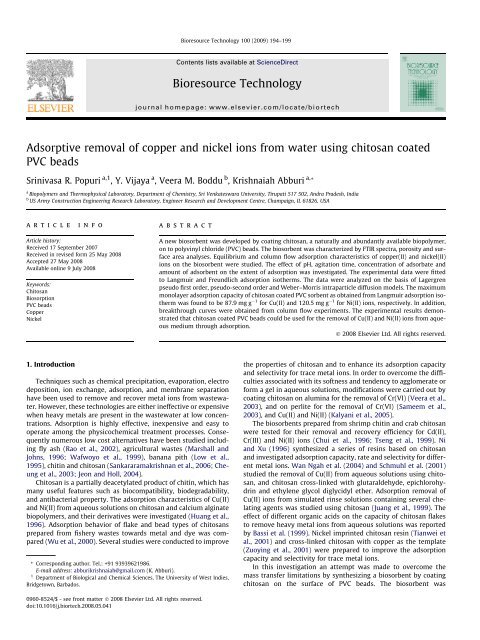
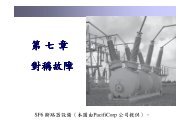
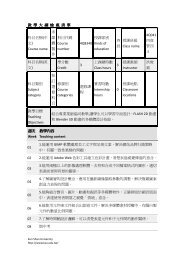
![char str[]](https://img.yumpu.com/49874120/1/190x134/char-str.jpg?quality=85)
